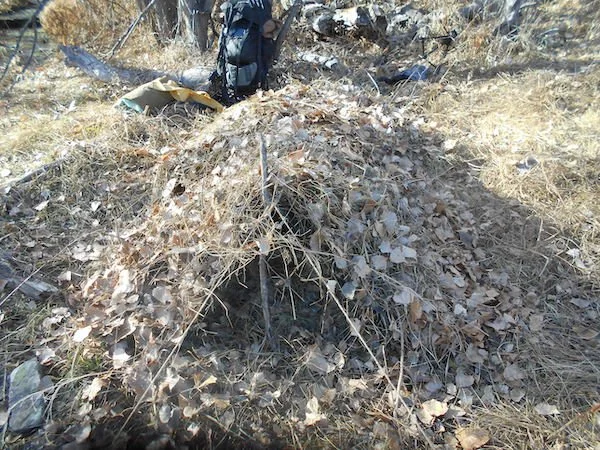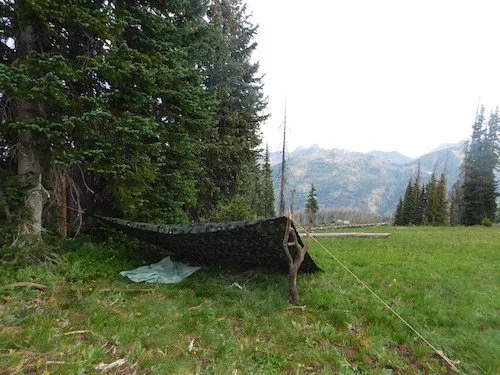Primitive Shelters - Two Simple Styles
An introduction to two kinds of primitive shelters.
When it comes to the topic of survival, there are several different branches a person can pursue. There are those who want to be prepared for any and all situations. Here I’m thinking Navy SEAL type training. It’s all modern and hard core. Then, you have the people who practice bushcraft. Bushcrafters are the people who learn all the traditional skills and tricks of living in the woods. They enjoy building things from nothing and learning to live in the woods, not just visit. Another group is what I’d call experimental historians. These people enjoy practicing historical skills in order to learn more about the reality of life in the past. Finally, you have the average camper. The average camper just wants to know enough to last one or two nights if a camping trip goes south. Although different, none of these approaches is wrong. Each group just has a different set of reasons for practicing survival skills. No matter what group you belong to, one topic you’ll benefit from learning about is shelter building.
Shelter building should be near the top of everyone’s “Survival Skills to Know” list. That’s because it is one of the most important to actually surviving. In the survival world, there is a rule that prioritizes the threats people face. I’ve heard it called the Rule of 3’s, and it goes like this:
You can survive 3 Minutes without air or in cold water.
You can survive 3 Hours without shelter in a harsh environment.
You can survive 3 Days without water.
You can survive 3 Weeks without food.
Although there are exceptions to this rule (like this story of a man who died in just 10 hours), this rule does provide a very rough idea of priorities. If you buy into this idea, you can realize why shelter building is so important.
When it comes to building primitive shelters, here are a few different types to consider.
Debris Shelter
A debris shelter need to be nothing more than a pile of dead leaves.
Maybe one of the most important properties a primitive shelter has is its ability to insulate you from the elements. Basically, insulation creates a barrier of dead air space between you and the elements. This not only keeps the cold air out, but it also keeps your body heat in. There are a few ways to do this, but perhaps the easiest is to simply pile plant debris into a pile.
I was first introduced to this idea while reading Tom Brown’s Field Guide to Wilderness Survival. In the book, Brown compares the debris shelter to a bird’s nest. Birds stay cozy in storms because they burrow down into a nest made of grass, sticks, and leaves. Fortunately, this debris provides the same benefit for you and me. In its simplest form, if you pile dead grass and leaves into a heap, and then burrow inside, you can create an effective shelter. The debris effectively creates a barrier that makes it difficult for a transfer of air to take place. The colder and wetter it is, the deeper the debris needs to be.
If you want to invest a little more energy, you can also build a frame to pile the debris on. This is more comfortable but does require more work. Personally, I’ve slept in these sorts of shelters into the teen temperatures and have found them to be very effective.
Tarp Shelter
A basic tarp shelter. On this night, I only needed it to protect from a potential rain shower while I slept.
Another type of primitive shelter that can be effective is the tarp shelter. Tarp shelters are good if you are not expecting cold weather, and just want a quick shelter that can protect you from the rain or wind. One of the best things about learning to make tarp shelters is the variety of configurations you can create for different situations. If one day you want an open-faced shelter you can create it, and if the next day you want something more closed in you, can create that instead. Unlike a tent, tarps provide a tremendous amount of flexibility. Personally, I’ve also pulled them out and wrapped them around my body like a blanket to outlast a brief downpour. After the storm passes in a few minutes, you simply fold up the tarp and resume what you were doing. If you are packing with your horses, you can also double your pack cover as a shelter.
Here is a video that shows the variety of different shelters you can make.
Although there are many different types of primitive shelters, these are two that I have used and found functional. Each style is useful for different situations and is worth being familiar with. Whether you are a bushcrafter, or just want to know how to get through an unexpected night, neither of these takes a tremendous of skill. They both require just a little bit of knowledge and provide you with two simple solutions to one of the most serious threats you are likely to face.


